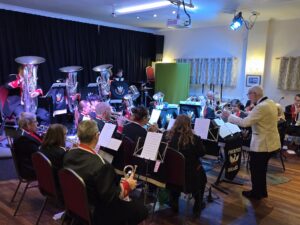
LAMBOURN IN THE 1930’s and 40’s, High Street (West Side)
With the kind permission of George Bodman.
A description of Lambourn and local characters, based on the memories of George, who for many years, until his retirement supplied coal and other fuels to Lambourn residents.
Mr HT Brown owned a shop on the corner facing the Market Place. A black bollard set into the footpath served for many years to prevent horses and traps bumping into the corner windows. The newspaper shop next door was owned by Arthur Palmer, but was taken over by his son Ron on his discharge from the army after being wounded at Dunkirk. Arthur and my Dad were the mainstays for the Bowls Club for many years. The beautiful “Gordon House” adjoining the paper shop was occupied by, Mrs Ainsworth from Bockhampton Farm.
High Street ( West Side )

Next-door was a sweet shop run by Veni Gosling until just before the War when she married Fred Hutchins. Fred ran the well-known building and undertaking firm of WT Adams & Co. Leslie Gosling and his sisters Mabel (a teacher) and Eunice (who ran the sweet shop and taxi service for school children) then occupied the attached accommodation. They had petrol pumps and it was interesting to see them turn the handle to register the number of gallons delivered. They also sold distilled water for car batteries. Leslie would sometimes help with the taxi work but he also owned and ran Foxbury Farm along the Wantage Road. He was clever at repairing machinery and many villagers became grateful for getting tractors to start after all else had failed. The Goslings also let a couple of rooms to the Westminster Bank for use on Thursdays. The brown ten-shilling, green pound and white five-pound notes went a very long way in those days!
Cecil Pike kept everything going whilst Leslie was away from the farm. He lived in the cottage at Foxbury farm and collected many cups and medals as centre forward for Lambourn soccer team.
Reg Payne ran the Post Office next to the Goslings. He knew everyone in the village. Ruth Mildenhall, a tall, slim lady and Jean Brittain both came fro Great Shefford to assist him. Gwen Buckeridge was the senior counter-clerk. She came from a devoutly Methodist farming family.
Next-door was the butchery shop owned by the Frooms but managed by Harry Ricketts who served in the ARP during the War. Boxer Ward delivered the meat in a wicker basket. Roy Brown was a delivery Boy but was also responsible for cleaning the counters and spreading sawdust on the floor.
Then we had “Thorne’s” a bicycle, wireless and hardware shop with three windows onto the street. Mr Thorne was a tall, well-built man, while Mrs Thorne was a pleasant, shorter lady who could soon find anything that was required from the hardware section. Their son Alan took over the running of the business in later years.
The adjoining “Universal Stores” owned by Lambourn Engineering was also a hardware shop and a veritable “Aladdin’s Cave”. It was run by the Thatcher family, who previously had a bicycle shop on the same plot of ground. Next-door was Mrs Ball’s wool shop, which was filled with many skeins of varied colours of wool and cotton, plus needles, threads and ribbons etc. The neighbouring house was occupied by Mr Ranger who was chauffeur to famous racehorse trainers such as Harry Cottrill at Seven Barrows.
Then came Mrs White’s shop, which formerly sold newspapers but later had sweets from glass jars and included a lending library. An adjacent alley was the entrance to the High Street Methodist Chapel. Malvern House beyond the alley was used for many years as a Methodist Manse. The adjacent house was occupied by Mr Hutchins of WT Adams & Co. who kept all their building supplies in a yard next to this house.
Then we come to the Police Station, manned by a sergeant and three constables. Regular court sessions were also held there with local magistrates attending. The nearby shop was taken over by Mr and Mrs Quallington about 1935 and run as a grocery shop with Mrs Stagg in assistance. The Quallington son (Bill) did not take to shop life but became a successful senior partner in a Newbury accountancy firm.
Mr T Rimmed occupied the large “Windsor House” near the top of the High Street. He was a successful racehorse trainer who hosted pre-War carnival activities and flower shows in his paddock looking towards Baydon. Sir Hugh Nugent lived here until the War. He was president of the Flower Show. The house at the corner of Crowle Road was used by, Lambourn Scouts, under the leadership of Captain Butler until the outbreak of war when Vernal Alexander took over.
“Many thanks to George for sharing his memories with us”
Liz Beard
February 2008





Thank you Liz, love the information about the Village. S o Good to know the information you have put info regarding the contacts and what is still so good our lovely village of Lambourn. Love so much the care you have for us oldies. Love to see all the youngsters are looking so happy in your lovely Photo. Howard I have met before and it is good to see what has been going on. Hope to see you about soon. XXXXXXXXX Doreen
Thank you, pleased that you like the website Doreen, it is always rewarding to receive nice feedback. We do our best! L.